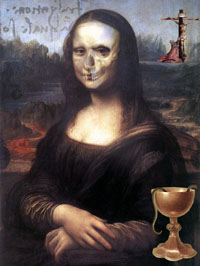Thursday, April 27, 2006
Da Vinci Code judge adds his own puzzle
2 comments
 Like we said earlier, everyone wants a piece of Dan Brown. If not his money, then his fame, if only for a moment.
Like we said earlier, everyone wants a piece of Dan Brown. If not his money, then his fame, if only for a moment.British judge Peter Smith, who presided over the Da Vinci Code trial for alleged plagiarism, has put his own secret code into his judgment and said he would "probably" confirm it to the person who breaks it.
Since the judgement was released on April 7, lawyers have begun noticing odd italicizations in the 71-page document. Would-be code breakers are now trying to decipher it.
"I can't discuss the judgment," Smith said Wednesday,"but I don't see why a judgment should not be a matter of fun."
Italics are placed in strange spots: The first is found in paragraph one of the 360-paragraph long document. The letter S in the word claimants is italicized. In the next paragraph, claimant is spelled "claiMant," and so on.
The italicized letters in the first seven paragraphs spell out "Smithy code," presumably playing on the judge's name.
The Associated Press reported:
Smith was arguably the highlight of the trial, with his sharp questions and witty observations making the sometimes dry testimony more lively. Though Smith on Wednesday refused to discuss the judgment or acknowledge outright that he'd inserted a secret code in its pages he said: "They don't look like typos, do they?"
When asked if someone would break the code, Smith said: "I don't know. It's not a difficult thing to do." And when asked if he would confirm a correct guess to an aspiring code-breaker, the High Court judge said, "probably."
Tench said the judge teasingly remarked that the code is a mixture of the italicized font code found in the book The Holy Blood and the Holy Grail — whose authors were suing Dan Brown's publisher, Random House, for copyright infringement — and the code found in Brown's The Da Vinci Code.
Authors Michael Baigent and Richard Leigh had sued Random House Inc., claiming Brown's best-selling novel "appropriated the architecture" of their 1982 nonfiction book, The Holy Blood and the Holy Grail.
Both books explore theories that Jesus married Mary Magdalene, the couple had a child and the bloodline survives, ideas dismissed by most historians and theologians.
"The Da Vinci Code" has sold more than 40 million copies — including 12 million hardcovers in the United States — since its release in March 2003. It came out in paperback in the United States earlier this year and quickly sold more than a million copies. An initial print run of 5 million has already been raised to 6 million.
Since the judgment was handed down three weeks ago, Tench said it took several weeks — and several watchful eyes — to spot the code. Now, London and New York attorneys are scrambling to decode the judgment.
"I think it has caught the particular imagination of Americans," Tench said. "To have a British, staid High Court judge encrypt a judgment in this manner, it's jolly fun."
After the "Smithy Code" series, there are an additional 25 jumbled letters contained on the first 14 pages of the document, Tench said, adding he thinks the series can be decoded using an anagram or an alphabet-inspired, code-breaking device. Known as a codex, the system is also found in Brown's The Da Vinci Code.
A codex uses the letters of the alphabet and matches them with an additional set of letters placed in a different order, dubbed a substitution cipher. It is derived from a scene in the novel where Harvard professor Robert Langdon and French cryptographer Sophie Neveu use the code to try to unravel the location of the Holy Grail, using a famed device invented by Leonardo Da Vinci for transporting secret messages.
"I'm definitely going to try to break the code," said attorney Mark Stephens, when learning of its existence.
"Judges have been known to write very sophisticated and amusing judgments," said Stephens, a lawyer specializing in media law and copyright issues. "This trend started long ago... one did a judgment in rhyme. Another in couplets. There has been precedent for this.
"It adds a bit of fun to what might have been a dusty text," he said.
Dan Brown | Da Vinci Code | The Solomon Key | Books | Plagiarism | Holy Blood, Holy Grail | Judge Peter Smith | Baigent and Leigh | Holy Blood, Holy Grail



